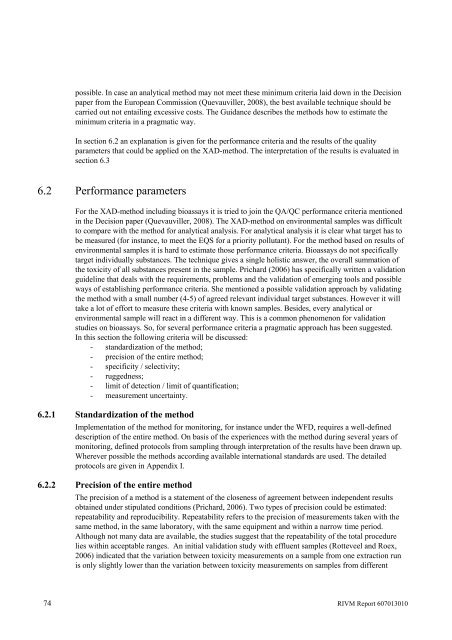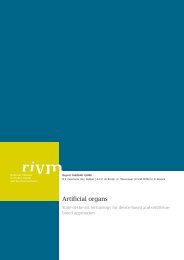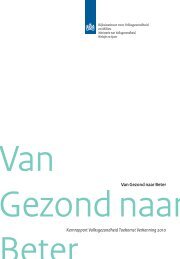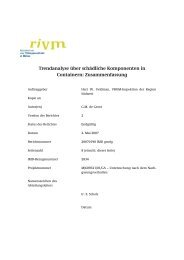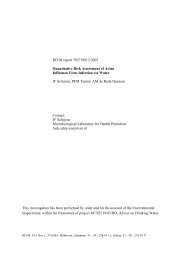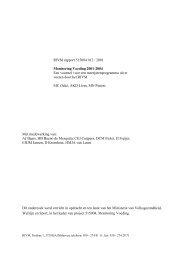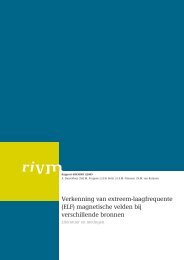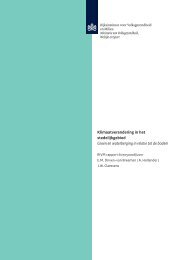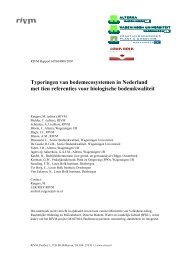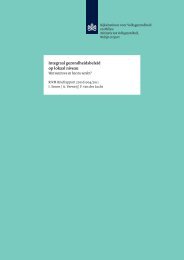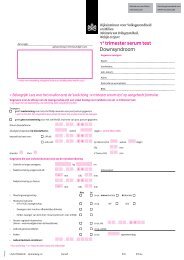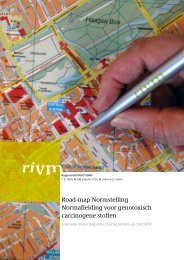Toxicity measurements in concentrated water samples - Rivm
Toxicity measurements in concentrated water samples - Rivm
Toxicity measurements in concentrated water samples - Rivm
You also want an ePaper? Increase the reach of your titles
YUMPU automatically turns print PDFs into web optimized ePapers that Google loves.
possible. In case an analytical method may not meet these m<strong>in</strong>imum criteria laid down <strong>in</strong> the Decision<br />
paper from the European Commission (Quevauviller, 2008), the best available technique should be<br />
carried out not entail<strong>in</strong>g excessive costs. The Guidance describes the methods how to estimate the<br />
m<strong>in</strong>imum criteria <strong>in</strong> a pragmatic way.<br />
In section 6.2 an explanation is given for the performance criteria and the results of the quality<br />
parameters that could be applied on the XAD-method. The <strong>in</strong>terpretation of the results is evaluated <strong>in</strong><br />
section 6.3<br />
6.2 Performance parameters<br />
For the XAD-method <strong>in</strong>clud<strong>in</strong>g bioassays it is tried to jo<strong>in</strong> the QA/QC performance criteria mentioned<br />
<strong>in</strong> the Decision paper (Quevauviller, 2008). The XAD-method on environmental <strong>samples</strong> was difficult<br />
to compare with the method for analytical analysis. For analytical analysis it is clear what target has to<br />
be measured (for <strong>in</strong>stance, to meet the EQS for a priority pollutant). For the method based on results of<br />
environmental <strong>samples</strong> it is hard to estimate those performance criteria. Bioassays do not specifically<br />
target <strong>in</strong>dividually substances. The technique gives a s<strong>in</strong>gle holistic answer, the overall summation of<br />
the toxicity of all substances present <strong>in</strong> the sample. Prichard (2006) has specifically written a validation<br />
guidel<strong>in</strong>e that deals with the requirements, problems and the validation of emerg<strong>in</strong>g tools and possible<br />
ways of establish<strong>in</strong>g performance criteria. She mentioned a possible validation approach by validat<strong>in</strong>g<br />
the method with a small number (4-5) of agreed relevant <strong>in</strong>dividual target substances. However it will<br />
take a lot of effort to measure these criteria with known <strong>samples</strong>. Besides, every analytical or<br />
environmental sample will react <strong>in</strong> a different way. This is a common phenomenon for validation<br />
studies on bioassays. So, for several performance criteria a pragmatic approach has been suggested.<br />
In this section the follow<strong>in</strong>g criteria will be discussed:<br />
- standardization of the method;<br />
- precision of the entire method;<br />
- specificity / selectivity;<br />
- ruggedness;<br />
- limit of detection / limit of quantification;<br />
- measurement uncerta<strong>in</strong>ty.<br />
6.2.1 Standardization of the method<br />
Implementation of the method for monitor<strong>in</strong>g, for <strong>in</strong>stance under the WFD, requires a well-def<strong>in</strong>ed<br />
description of the entire method. On basis of the experiences with the method dur<strong>in</strong>g several years of<br />
monitor<strong>in</strong>g, def<strong>in</strong>ed protocols from sampl<strong>in</strong>g through <strong>in</strong>terpretation of the results have been drawn up.<br />
Wherever possible the methods accord<strong>in</strong>g available <strong>in</strong>ternational standards are used. The detailed<br />
protocols are given <strong>in</strong> Appendix I.<br />
6.2.2 Precision of the entire method<br />
The precision of a method is a statement of the closeness of agreement between <strong>in</strong>dependent results<br />
obta<strong>in</strong>ed under stipulated conditions (Prichard, 2006). Two types of precision could be estimated:<br />
repeatability and reproducibility. Repeatability refers to the precision of <strong>measurements</strong> taken with the<br />
same method, <strong>in</strong> the same laboratory, with the same equipment and with<strong>in</strong> a narrow time period.<br />
Although not many data are available, the studies suggest that the repeatability of the total procedure<br />
lies with<strong>in</strong> acceptable ranges. An <strong>in</strong>itial validation study with effluent <strong>samples</strong> (Rotteveel and Roex,<br />
2006) <strong>in</strong>dicated that the variation between toxicity <strong>measurements</strong> on a sample from one extraction run<br />
is only slightly lower than the variation between toxicity <strong>measurements</strong> on <strong>samples</strong> from different<br />
74 RIVM Report 607013010


